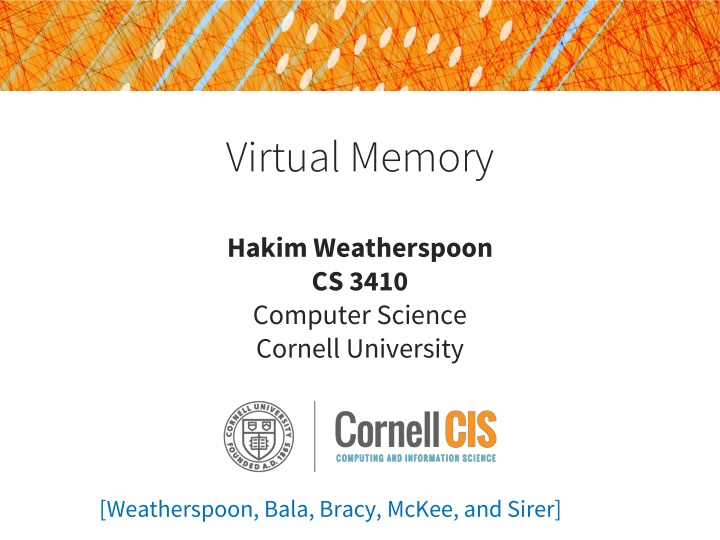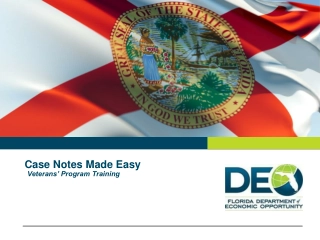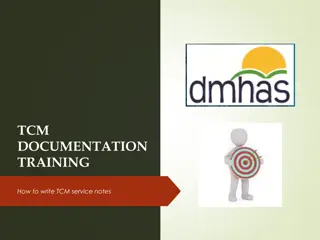
Virtual Memory and Multiple Processes in Computer Science
Explore the concepts of virtual memory, running multiple programs concurrently, and managing processes in computer systems. Learn about memory addressing, process execution, and optimizing program performance.
Download Presentation

Please find below an Image/Link to download the presentation.
The content on the website is provided AS IS for your information and personal use only. It may not be sold, licensed, or shared on other websites without obtaining consent from the author. If you encounter any issues during the download, it is possible that the publisher has removed the file from their server.
You are allowed to download the files provided on this website for personal or commercial use, subject to the condition that they are used lawfully. All files are the property of their respective owners.
The content on the website is provided AS IS for your information and personal use only. It may not be sold, licensed, or shared on other websites without obtaining consent from the author.
E N D
Presentation Transcript
Virtual Memory Hakim Weatherspoon CS 3410 Computer Science Cornell University [Weatherspoon, Bala, Bracy, McKee, and Sirer]
Where are we now and where are we going? How many programs do you run at once? a) 1 b) 2 c) 3-5 d) 6-10 e) 11+ 2
Big Picture: Multiple Processes Can we execute more than one program at a time with our current RISC-V processor? a) Yes, no problem at all b) No, because memory addresses will conflict c) Yes, caches can avoid memory address conflicts d) Yes, our modified Harvard architecture avoids memory address conflicts e) Yes, because we have multiple processors (multiple cores) 3
Big Picture: Multiple Processes How to run multiple processes? Time-multiplex a single CPU core (multi-tasking) Web browser, skype, office, all must co-exist Many cores per processor (multi-core) or many processors (multi-processor) Multiple programs run simultaneously 4
Processor & Memory CPU address/data bus... routed through caches to main memory Simple, fast, but 0xfff f CPU 0x7ff f Stack $$ Heap Data Text 0x000 0 Memory 5
Multiple Processes Q: What happens when another program is executed concurrently on another processor? 0xfff f CPU 0x7ff f Stack Stack $$ $$ Heap Heap CPU Data Data A: The addresses will conflict Even though, CPUs may take turns using memory bus Text Text 0x000 0 Memory 6
Multiple Processes Q: Can we relocate second program? 0xfff f CPU 0x7ff f Stack Stack $$ $$ Heap Heap CPU Data Data Text Text 0x000 0 Memory 7
Solution? Multiple processes/processors Q: Can we relocate second program? A: Yes, but What if they don t fit? What if not contiguous? Need to recompile/relink? Stack CPU Data Stack Heap Heap CPU Data Text Text Memory 8
Big Picture: (Virtual) Memory 3 2 1 0 A B C D Process 1 Give each process an illusion that it has exclusive access to entire main memory 3 2 1 0 E F G H Process 2 9
But In Reality 14 13 D 12 Process 1 11 E 10 9 C 8 7 B G H 6 5 4 Process 2 3 A 2 F 1 0 Physical Memory 10
How do we create the illusion? 14 13 D 12 3 2 1 0 A B C D Process 1 11 E 10 9 C 8 7 B G H 6 5 3 2 1 0 E F G H 4 Process 2 3 A 2 F 1 0 Physical Memory 11
How do we create the illusion? 14 13 D 12 3 2 1 0 A B C D Process 1 11 E 10 9 C All problems in computer science can be solved by another level of indirection. 8 7 B G H David Wheeler 6 5 3 2 1 0 E F G H 4 Process 2 3 A 2 F 1 0 Physical Memory 12
How do we create the illusion? 14 13 D 12 3 2 1 0 A B C D Process 1 11 E 10 Map virtual address to physical address Physical address 9 C 8 7 Virtual address B G H Memory 6 management unit (MMU) takes care of the mapping 5 3 2 1 0 E F G H 4 Process 2 3 A 2 F 1 Virtual Memory (just a concept; does not exist physically) 0 Physical Memory 13
How do we create the illusion? 14 Process 1 wants to access data C Process 1 thinks it is stored at addr 1 So CPU generates addr 1 This addr is intercepted by MMU MMU knows this is a virtual addr MMU looks at the mapping Virtual addr 1 -> Physical addr 9 Data at Physical addr 9 is sent to CPU And that data is indeed C!!! 13 D 12 3 2 1 0 A B C D Process 1 11 E 10 Physical address 9 C 8 7 Virtual address B G H 6 5 3 2 1 0 E F G H 4 Process 2 3 A 2 F 1 Virtual Memory (just a concept; does not exist physically) 0 Physical Memory 14
How do we create the illusion? 14 13 D 12 3 2 1 0 A B C D Process 1 11 E 10 Map virtual address to physical address 9 C 8 7 B G H Memory 6 management unit (MMU) takes care of the mapping 5 3 2 1 0 E F G H 4 Process 2 3 2 1 Virtual Memory 0 A F Physical Memory 15 Disk
Big Picture: (Virtual) Memory From a process s perspective Hidden from Process 3 2 1 0 A B C D Process 1 C Physical Memory Virtual Memory Process only sees the virtual memory Contiguous memory 16
Big Picture: (Virtual) Memory From a process s perspective Hidden from Process 3 2 1 0 A B C D Process 1 C Physical Memory Virtual Memory Process only sees the virtual memory Contiguous memory No need to recompile - only mappings need to be updated 17
Big Picture: (Virtual) Memory From a process s perspective Hidden from Process C 3 2 1 0 A B C D Process 1 Physical Memory Virtual Memory Process only sees the virtual memory Contiguous memory No need to recompile - only mappings need to be updated 18
Big Picture: (Virtual) Memory From a process s perspective Hidden from Process 3 2 1 0 A B C D Process 1 Physical Memory Virtual Memory Process only sees the virtual memory Contiguous memory No need to recompile - only mappings need to be updated When run out of memory, MMU maps data on disk in a transparent manner Disk C 19
Next Goal How does Virtual Memory work? i.e. How do we create the map that maps a virtual address generated by the CPU to a physical address used by main memory? 20
Next Goal (after spring break!) How does Virtual Memory work? i.e. How do we create the map that maps a virtual address generated by the CPU to a physical address used by main memory? 21
Virtual Memory Agenda What is Virtual Memory? How does Virtual memory Work? Address Translation Overhead Paging Performance 23
Virtual Memory: Recap Store B at 2 Load data at 2 Hidden from the process 14 13 12 3 2 1 0 11 Process 1 B 10 9 Physical address 8 7 Virtual address B 6 5 H 4 3 2 1 0 Process 2 3 2 Store H at 2 1 0 Virtual Memory {just a set of numbers (addresses); does not exist physically} Physical Memory 24
Picture Memory as ? Byte Array: Segments: Page Array: data xaa x00 addr 0xfffffffc system reserved page n 0xffffffff 0xfffff000 0x80000000 0x7ffffffc 0xffffe000 stack 0xffffd000 . . . heap 0x00004000 data 0x10000000 . . . 0x00003000 x00 xef xcd xab xff x00 page 2 text 0x00002000 0x00400000 page 1 0x00001000 system reserved page 0 0x00000000 0x00000000 0x00000000 25
A Little More About Pages Page Array: Memory size = depends on system say 4GB 4KB 0xfffff000 Page size = 4KB (by default) 0xffffe000 Then, # of pages = 2^20 0xffffd000 Any data in a page # 2 has address of the form: 0x00002xxx Lower 12 bits specify which byte you are in the page: 0x00002200 = 0010 0000 0000 0x00004000 0x00003000 = byte 512 0x00002000 upper bits = page number (PPN) lower bits = page offset 0x00001000 0x00000000 26
Page Table:Datastructure to store mapping 1 Page Table per process Lives in Memory, i.e. in a page (or more ) Location stored in Page Table Base Register 9 8 7 6 5 4 3 2 1 0 0x00008FFF . . . C B 0x0000800c 00000001 00000004 00000005 00000000 0x00008008 0x00008004 0x00008000 A Part of program state (like PC) PTBR 0x00008000 Physical Address Space 27 Assuming each page = 4KB
Address Translator: MMU Programs use virtual addresses Actual memory uses physical addresses 3 2 1 0 A B C D 9 8 7 6 5 4 3 2 1 0 C B C B Program #1 MMU Memory Management Unit (MMU) HW structure Translates virtual physical address on the fly D A 3 2 1 0 A B C D Physical Address Space Memory (DRAM) Program #2 28
Simple Page Table Translation 0x00008FFF 0xC20A3000 0x10045 paddr . . . 0x4123B 0xABC 0x9000000c 0xC20A3 0x4123B 0x10044 0x00000 0x90000000 0x90000008 0x90000004 0x4123BABC 0x90000000 0x4123B000 0 31 12 11 vaddr 0x00002 0xABC 0x10045000 page offset index into the page table 0x10044000 PTBR 0x90000000 0x00000000 Memory 29 Assuming each page = 4KB
General Address Translation What if the page size is not 4KB? Page offset is no longer 12 bits Clicker Question: Page size is 16KB how many bits is page offset? (a) 12 (b) 13 (c) 14 What if Main Memory is not 4GB? Physical page number is no longer 20 bits Clicker Question: Page size 4KB, Main Memory 512 MB (a) 15 (b) 16 (c) 17 (d) 15 (e) 16 how many bits is PPN? (d) 18 (e) 19 30
Virtual Memory: Summary Virtual Memory: a Solution for All Problems Each process has its own virtual address space Program/CPU can access any address from 0 2N-1 (N=number of bits in address register) A process is a program being executed Programmer can code as if they own all of memory On-the-fly at runtime, for each memory access all accesses are indirect through a virtual address translate fake virtual address to a real physical address redirect load/store to the physical address map 31
Advantages of Virtual Memory Easy relocation Loader puts code anywhere in physical memory Virtual mappings to give illusion of correct layout Higher memory utilization Provide illusion of contiguous memory Use all physical memory, even physical address 0x0 Easy sharing Different mappings for different programs / cores And more to come 32
Takeaway All problems in computer science can be solved by another level of indirection. Need a map to translate a fake virtual address (generated by CPU) to a real physical Address (in memory) Virtual memory is implemented via a Map , a PageTage, that maps a vaddr (a virtual address) to a paddr (physical address): paddr = PageTable[vaddr] 33
Feedback How much did you love today s lecture? A: As much as Melania loves Trump B: As much as Kanye loves Kanye C: Somewhere in between, but closer to A D: Somewhere in between, but closer to B E: I am incapable of loving anything 34
Virtual Memory Agenda What is Virtual Memory? How does Virtual memory Work? Address Translation Overhead Paging Performance 35
Page Table Overhead How large is PageTable? Virtual address space (for each process): Given: total virtual memory: 232 bytes = 4GB Given: page size: 212 bytes = 4KB # entries in PageTable? size of PageTable? Physical address space: total physical memory: 229 bytes = 512MB overhead for 10 processes? 220 = 1 million entries PTE size = 4 bytes PageTable size = 4 x 220 = 4MB 10 x 4MB = 40 MB of overhead! 40 MB /512 MB = 7.8% overhead, space due to PageTable 36
But Wait... Theres more! Page Table Entry won t be just an integer Meta-Data Valid Bits - What PPN means not mapped ?No such number - At first: not all virtual pages will be in physical memory - Later: might not have enough physical memory to map all virtual pages Page Permissions - R/W/X permission bits for each PTE - Code: read-only, executable - Data: writeable, not executable 37
Less Simple Page Table Physical Page Number V R W X 0 1 1 1 0 0 0 1 1 0 0 1 1 0 Process tries to access a page without proper permissions Segmentation Fault Example: Write to read-only? process killed 0xC20A3000 0xC20A3 0x90000000 0xC20A3 0x4123B 0x10044 0x4123B000 0x10045000 0x10044000 0x00000000 38
Now how big is this Page Table? struct pte_t page_table[220] Each PTE = 8 bytes How many pages in memory will the page table take up? Clicker Question: (a) 4 million (222) pages (b) 2048 (211) pages (c) 1024 (210) pages (d) 4 billion (232) pages (e) 4K (212) pages Assuming each page = 4KB 39
Now how big is this Page Table? struct pte_t page_table[220] Each PTE = 8 bytes How many pages in memory will the page table take up? Clicker Question: (a) 4 million (222) pages (b) 2048 (211) pages (c) 1024 (210) pages (d) 4 billion (232) pages (e) 4K (212) pages Assuming each page = 4KB 40
Wait, how big is this Page Table? page_table[220] = 8x220 =223 bytes (Page Table = 8 MB in size) How many pages in memory will the page table take up? 223 /212 =211 2K pages! Clicker Question: (a) 4 million (222) pages (b) 2048 (211) pages (c) 1024 (210) pages (d) 4 billion (232) pages (e) 4K (212) pages 41 Assuming each page = 4KB
Takeaway All problems in computer science can be solved by another level of indirection. Need a map to translate a fake virtual address (generated by CPU) to a real physical Address (in memory) Virtual memory is implemented via a Map , a PageTage, that maps a vaddr (a virtual address) to a paddr (physical address): paddr = PageTable[vaddr] A page is constant size block of virtual memory. Often, the page size will be around 4kB to reduce the number of entries in a PageTable. We can use the PageTable to set Read/Write/Execute permission on a per page basis. Can allocate memory on a per page basis. Need a valid bit, as well as Read/Write/Execute and other bits. But, overhead due to PageTable is significant. 42
Next Goal How do we reduce the size (overhead) of the PageTable? 43
Next Goal How do we reduce the size (overhead) of the PageTable? A: Another level of indirection!! 44
Single-Level Page Table vaddr 20 bits 12 bits 31 12 11 0 Total size = 220 * 4 bytes = 4MB PTEntry PPN PTBR Page Table 45
Multi-Level Page Table vaddr 10 bits 10 bits 12 bits 31 22 21 12 11 0 PTEntry PPN PDEntry Also referred to as Level 1 and Level 2 Page Tables Page Table PTBR Page Directory * Indirection to the Rescue, AGAIN! 46
Multi-Level Page Table vaddr 10 bits 10 bits 12 bits 31 22 21 12 11 0 Assuming each entry is 4bytes,What is the size of Page Directory? A: 2KB B: 2MB C: 4KB D: 4MB PTEntry PPN PDEntry Also referred to as Level 1 and Level 2 Page Tables Page Table PTBR Page Directory * Indirection to the Rescue, AGAIN! 47
Multi-Level Page Table vaddr 10 bits 10 bits 12 bits 31 22 21 12 11 0 Assuming each entry is 4bytes,What is the total size of ALL Page tables? A: 2KB B: 2MB C: 4KB D: 4MB PTEntry PPN PDEntry Also referred to as Level 1 and Level 2 Page Tables Page Table PTBR Page Directory * Indirection to the Rescue, AGAIN! 48
Multi-Level Page Table vaddr 10 bits 10 bits 12 bits 31 22 21 12 11 0 PTEntry PPN PDEntry Page Table Size = 210 * 210 *4 bytes = 4MB PTBR Page Directory Size = 210 * 4 bytes = 4KB # entries per page table # page tables 49
Multi-Level Page Table Doesn t this take up more memory than before? - YES, but.. Benefits Don t need 4MB contiguous physical memory Don t need to allocate every PageTable, only those containing valid PTEs Drawbacks Performance: Longer lookups 50






















